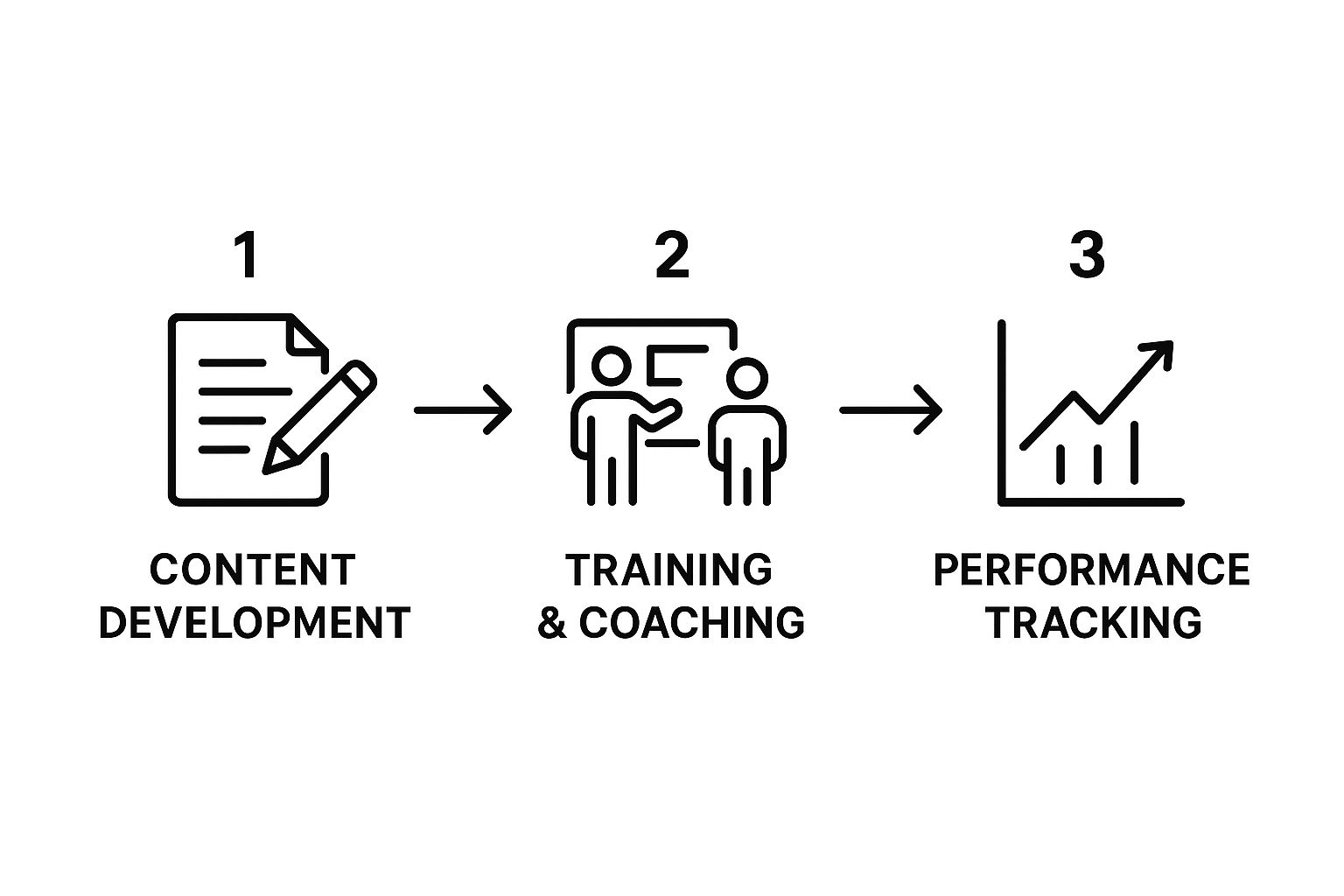Let’s be honest, most people hear “sales enablement” and their eyes glaze over. They picture a dusty folder of outdated PDFs and a clunky CRM nobody uses. But a real sales enablement strategy? It’s the central nervous system of your sales operation. It’s the ongoing, living process of giving your sales team the right tools, training, and content to actually sell effectively.
This isn’t a one-and-done project. It’s a constant effort to close the gap between your marketing and sales teams, making sure every rep has what they need to smash their targets and drive real growth.
Why A Sales Enablement Strategy Is Non-Negotiable

Sending your sales team out without a formal enablement strategy is like giving them a car with no map, no fuel, and a flat tyre. You might get a few lucky wins, but consistent success? Forget about it. In the fiercely competitive Irish B2B market, this lack of direction has real, measurable costs that bring growth to a grinding halt.
When reps are left to their own devices, inconsistent messaging spreads like wildfire. One salesperson might pitch your product on its cost-saving features, while another hammers home the technical specs. This doesn't just confuse potential buyers; it actively chips away at your brand's credibility. It makes it nearly impossible for prospects to see a clear, unified reason to choose you.
This ad-hoc approach kills performance. Without structured onboarding and continuous coaching, new hires take forever to get up to speed, and even your veterans will struggle to adapt to new products or market shifts. What you end up with is a toxic cycle of missed quotas, frustrated teams, and high turnover—all of which hit your bottom line, hard. We've got more practical advice on this in our guide on building a startup sales team.
The Core Pillars Of A Modern Sales Enablement Strategy
To fight back against these challenges, a modern sales enablement strategy needs to be built on a few core pillars. Think of these as the legs of the stool—if one is wobbly, the whole thing comes crashing down. They work together to create a solid system that empowers your entire sales organisation.
A well-designed strategy is built around these fundamental components, each with its own clear objective.
| Pillar | Objective | Key Activities |
|---|---|---|
| Content Strategy | Arm reps with relevant, hard-hitting content for every stage of the buyer's journey. | Creating sharp case studies, battle cards, email templates, and product one-pagers. |
| Training & Coaching | Boost seller skills, knowledge, and confidence through ongoing development. | Implementing structured onboarding, role-playing sessions, product training, and call coaching. |
| Technology & Tools | Equip the team with the right tech stack to streamline workflows and crush their numbers. | Setting up a CRM, a content management system (CMS), and call intelligence software. |
| Performance Analytics | Measure what’s working (and what’s not) to continuously improve enablement efforts. | Tracking crucial KPIs like quota attainment, win rates, and sales cycle length. |
These pillars ensure your team isn't just working hard, but working smart. They provide the structure needed to scale your sales efforts effectively.
A well-executed sales enablement strategy acts as the central nervous system for your sales organisation. It aligns people, processes, and content to ensure every rep can have the most effective conversation possible with every prospect, every time.
The market trends tell the same story. In 2024, the global sales enablement platform market soared to a value of around $5.23 billion. And it's not slowing down—it's projected to grow at a compound annual growth rate (CAGR) of 16.3% through 2030. This boom is fueled by the widespread adoption of AI-powered coaching and integrated digital platforms. It’s clear proof that businesses are doubling down on strategies that improve the experience for both buyers and sellers. You can get more insights on the future of sales enablement on mtlc.co.
Building a Rock-Solid Foundation for Enablement
A winning sales enablement strategy isn't something you can just buy off the shelf or dream up over a weekend. Before you design a single piece of content or book a training session, you have to lay the groundwork. This foundation is what makes sure all your hard work is targeted, supported by the right people, and ultimately, actually works.
First things first: you need to break down the walls between departments. A successful strategy demands a cross-functional team where everyone has some skin in the game. This isn’t just a sales project; it's a company-wide push. Your core crew should pull in key players from sales, marketing, and even product development to get different perspectives and build support across the business.
Conduct a Thorough Audit
With your team assembled, the next move is to take a brutally honest look at what you’ve already got. This means digging deep into your existing sales content, your current processes, and the tools your team uses day-to-day. You’re hunting for what’s working, what’s obviously broken, and where the most painful gaps are. Don’t just scroll through content libraries—listen to call recordings and sit in on sales meetings.
Pinpoint the friction. Where are your reps getting stuck? Are they scrambling to find the right case study for a specific industry? Is the onboarding process leaving them unprepared to handle common objections? The point of this audit isn't to assign blame. It’s to create a clear, unvarnished map of your current reality so you can chart a course forward.
Set Clear Goals and Secure Buy-In
Once you know where the landmines are, you can set clear, measurable goals. Vague ambitions like "improve sales" are useless here. You need specific targets that tie directly to real business outcomes.
Here are a few examples of strong, measurable goals that get attention:
- Reduce new hire ramp-up time from six months down to four.
- Increase the average deal size by 15% within the next three quarters.
- Boost our competitive win rate against our main rival from 30% to 45%.
- Improve quota attainment from 60% of the team to 80% by the end of the year.
These kinds of specific goals are the backbone of your business case for getting executive buy-in. When you can walk into a leadership meeting and show exactly how your sales enablement plan will impact the bottom line, it stops being a "nice-to-have" expense and becomes an essential investment. This is even more crucial when you need to manage a remote sales team, as clear goals and solid support are what keep everyone aligned and pulling in the same direction.
This visual gives you a simple look at how these foundational elements connect to the ongoing work of enablement.

As you can see, a solid foundation logically flows into creating targeted content. That content then fuels effective training and coaching, with everything being tracked and measured to prove its impact.
Creating Content and Training That Actually Work

This is where the rubber meets the road. You can have the best strategy on paper, but if your sales team doesn't have the right words, assets, and confidence, it's all just theory. Simply dumping a folder of PDFs on them and hoping for the best is a recipe for failure.
Your content and training need to be living, breathing parts of your sales motion—dynamic, relevant, and directly plugged into the buyer's journey. Let's be honest: a top-of-funnel blog post won't help close a deal hanging by a thread, and a technical deep-dive is overkill for a first discovery call. It’s all about the right tool, for the right job, at the right time.
Mapping Content to the Buyer Journey
To make your content library more than just a digital filing cabinet, you have to map every single asset to a specific stage in your sales process. This gives your team a playbook for every conversation, moving buyers from one stage to the next with confidence.
Think of it as building a full toolkit, not just handing everyone the same hammer. Here’s a practical way to break it down:
- Awareness Stage: At this point, reps need content that educates prospects and frames their problems. Think high-level industry reports, insightful blog posts, or short videos that highlight a common pain point without being salesy.
- Consideration Stage: As buyers start sizing up their options, you need to build trust and show why your solution is the smart choice. This is the perfect time to deploy detailed case studies, webinar recordings, or even competitor battle cards.
- Decision Stage: To get the deal over the line, your reps need assets that justify the investment and crush any last-minute objections. This is where ROI calculators, implementation guides, and security documentation become invaluable.
When you take this approach, your content library stops being a passive archive and becomes an active selling weapon. It eliminates the guesswork for your reps and makes them far more credible in the eyes of the prospect.
Your sales content shouldn’t just inform; it should empower. Every asset must have a clear purpose—to answer a specific question, handle a specific objection, or guide a prospect to the next logical step.
Training That Actually Sticks
Even the most brilliant content is useless if your reps don’t know how to wield it effectively. Forget those soul-crushing, all-day training sessions that just lead to information overload. Modern sales training needs to be continuous, engaging, and mirror the real world your team operates in. A successful sales enablement strategy is built on practical application, not just theory.
A great way to do this is with micro-learning modules—short, punchy videos or guides that reps can consume in just a few minutes. They're perfect for reinforcing a key skill or rolling out a new product feature without pulling them away from selling.
Role-playing is another absolute non-negotiable. Get your team to simulate realistic sales scenarios, forcing them to handle tough objections or use a new battle card on the fly. This builds muscle memory and gives them the confidence they need for live conversations. As you build out these materials, remember they support the entire sales cycle, from that first cold email to the final signature. We cover the initial outreach part of this in our guide on lead generation for startups.
Finally, you need a powerful feedback loop. This doesn't have to be complicated. A dedicated Slack channel or a simple form in your CRM where reps can request new content or share what’s landing well with prospects is all it takes. This ensures your materials never get stale and your enablement efforts stay perfectly aligned with what the team on the front lines actually needs.
Choosing Your Sales Enablement Tech Stack
Technology is the engine that powers a modern sales enablement strategy. But let's be honest: picking the right tools can feel like navigating a minefield. With a new platform launching seemingly every week, it’s easy to get overwhelmed and sink money into complex software that just complicates things for your team.
The goal isn't to buy the most expensive tools; it’s to build a cohesive tech stack that actually supports what your reps do every single day.
A strong stack acts as an accelerator, automating the tedious stuff and delivering critical insights right when reps need them most. Without the right technology, even the best content and training will struggle to gain traction, getting lost in messy shared drives or forgotten after a single training session.
The Essential Components of a Modern Stack
Your tech stack doesn't need to be massive, but it does need to cover the core functions of enablement. Think of these as the foundational building blocks for equipping your sales team.
Here are the critical categories to get right:
- Content Management System (CMS): This needs to be your single source of truth for all sales collateral. A good sales CMS doesn’t just store files; it helps reps find the perfect case study or battle card for any deal, often right within their CRM. No more hunting through folders.
- Learning Management System (LMS): This platform is home to your onboarding materials, training modules, and coaching content. It allows you to deliver consistent training at scale and see exactly where each rep is on their learning journey.
- Sales Coaching & Intelligence: These tools, often powered by AI, are a game-changer. They record and analyse sales calls, giving you objective data on what your top performers are doing differently. This helps managers identify coaching opportunities and give targeted, effective feedback that actually sticks.
Remember, the goal of your tech stack is empowerment, not surveillance. Choose tools that make your sellers' lives easier and their conversations more effective, and they'll happily adopt them.
The Game-Changing Role of Artificial Intelligence
AI is no longer some futuristic buzzword in sales; it's a fundamental part of a high-performing sales enablement strategy. AI-powered tools are now automating content suggestions during calls, personalising coaching plans based on individual performance, and delivering predictive insights about which deals are at risk.
The market data backs this up. A recent 2025 report found that a staggering 90% of companies have either already implemented AI in their enablement efforts or plan to do so within the year. This near-total adoption shows that AI has become table stakes for competing effectively, especially as buyer expectations and revenue targets climb. You can read the full report from Highspot for more details on these trends.
For Irish B2B companies, this is a massive opportunity. AI can help your team punch well above its weight, personalising outreach at a scale that was previously impossible. It's about working smarter, not just harder.
A Practical Framework for Vendor Evaluation
Choosing the right vendors is critical. Before you get locked into any contracts, run potential platforms through a simple, practical framework to make sure they’re the right fit for your business.
- Integration Capability: Does it seamlessly connect with your existing CRM and other core tools? A platform that creates data silos is a step backwards, not forwards.
- User Experience (UX): Is it intuitive for your reps to use? If it requires hours of training just to do basic tasks, your adoption rates will plummet. Your team has to want to use it.
- Scalability and Cost: Will the tool grow with you? Look beyond the initial license fee and consider the total cost of ownership. Make sure it aligns with your budget now and your growth plans for the future.
By focusing on these core areas, you can build a tech stack that genuinely accelerates your sales enablement strategy and gives your team the tools they need to win more deals.
Measuring the True Impact of Your Strategy

Let's be blunt: a sales enablement strategy without measurement is just wishful thinking. If you can't prove its value and secure ongoing support from the higher-ups, you're just spinning your wheels. The key is connecting your efforts directly to real business outcomes.
That means moving beyond simple vanity metrics like content downloads. No one in the C-suite cares how many times a PDF was viewed. They care about KPIs that move the needle.
To get a complete picture, you need to track a balanced mix of leading and lagging indicators. Leading indicators are the forward-looking metrics that predict future success, while lagging indicators show you what's already happened. It’s the difference between seeing a storm on the radar and standing in the rain.
Key Performance Indicators to Track
When you're building a measurement framework, you need to focus on metrics that tell a clear story about sales effectiveness and efficiency. Forget the fluff.
Here are the essential KPIs you should be laser-focused on:
- Quota Attainment: The percentage of reps hitting or exceeding their sales targets. This is the ultimate measure of your team’s productivity. Are they winning?
- New Hire Ramp-Up Time: How long does it take for a new salesperson to become fully productive? A shorter ramp time is a direct signal that your onboarding and training are working.
- Sales Cycle Length: The average time it takes to close a deal, from first contact to signed contract. An effective strategy should shrink this cycle by arming reps with the right content and tools at the right time, removing friction along the way.
- Win Rate: What percentage of qualified opportunities are your reps actually winning? This KPI directly reflects your team's ability to compete and close.
- Average Contract Value (ACV): The average value of your signed deals. When enablement is successful, reps articulate value more effectively, which naturally leads to larger contracts.
The most powerful thing you can do is show a direct line from your enablement activities—like a new training module or content asset—to an improvement in these core metrics. That’s how you prove undeniable ROI.
Building a dashboard that visualizes these metrics is critical for communicating your impact to stakeholders. This gives you a clear, data-driven narrative about how your sales enablement strategy is fueling revenue growth. For a deeper dive, check out our comprehensive guide on tracking sales performance.
Staying Ahead of Industry Shifts
Measurement isn't just about proving past success; it’s about adapting to what's next. The sales landscape is constantly shifting, with new buyer behaviours and technologies popping up all the time.
A 2025 survey of senior B2B leaders, for example, revealed a massive shift toward AI-driven coaching and digital-first buyer engagement. Traditional sales tactics are being replaced by hyper-personalized experiences, forcing sales teams to get comfortable with new tech and data analytics.
As buyers expect more tailored interactions, your sales enablement strategy has to evolve to meet these demands. You can discover more insights on Allego.com about how AI is transforming the field. This data-driven approach allows you to continuously refine your program, ensuring your team is always equipped to win.
Answering Your Toughest Sales Enablement Questions
Look, even the most watertight plan springs a few leaks once you put it into action. As you start building out your sales enablement strategy, questions and roadblocks are not just likely—they're guaranteed. How you handle these hurdles is what separates a strategy that looks good on paper from one that actually fuels your revenue growth.
Let’s dive into some of the most common questions I hear from teams on the ground.
One of the biggest struggles? Adoption. You can build the most beautiful, insightful library of sales content the world has ever seen, but if your reps aren’t using it, it’s completely worthless.
The secret to adoption is painfully simple: make it easier for reps to use your content than to ignore it. This boils down to less friction, more relevance, and clear, undeniable proof that it helps them win.
Getting reps to actually use new material starts by bringing them into the creative process from day one. Your top performers are on the front lines every single day; they know what works. Use their insights to build battle cards and case studies that solve the real problems they face.
Next, you have to embed your content library directly into their daily workflow—right inside your CRM is ideal. This simple step stops them from having to dig through a maze of folders and lets them pull the perfect asset right in the middle of a conversation.
Sales Enablement vs. Sales Operations
Another classic point of confusion is the line between sales enablement and sales operations. They’re close partners, no doubt, but they have very distinct jobs.
Think of it like a professional racing team.
Sales Operations is the pit crew. They're obsessed with the mechanics of the sales engine—things like territory planning, compensation structures, CRM administration, and forecasting. Their job is to make sure the car is built to win.
Sales Enablement, on the other hand, is the driver’s coach. We focus on the effectiveness of the seller. We provide the training, the content, and the coaching to make them better at engaging buyers and closing deals. One team builds the engine; the other provides the high-octane fuel and sharpens the driver's skill. A big part of this is improving specific skills through proven sales coaching techniques that deliver a real, tangible boost in performance.
Can Small Businesses Succeed Without Big Budgets?
There’s a common myth floating around that a powerful sales enablement strategy is a luxury reserved for massive companies with deep pockets. That couldn't be further from the truth. At its core, enablement is a strategy, not just a suite of expensive tools.
Small businesses can absolutely build a high-impact strategy by focusing on results over resources. Start by identifying the single biggest pain point your team has.
Is it inconsistent onboarding? Create a simple, standardised 30-day plan using shared documents. Is your team getting hammered by a key competitor? Work with your best rep to build a single, brutally effective battle card.
- Solve one problem at a time. Don't try to boil the ocean.
- Use free or low-cost tools. Google Drive can be your first content management system. No shame in that.
- Stay consistent. Regular, informal role-playing sessions can be far more effective than a pricey annual training conference.
The key isn't the size of your budget; it's the consistency of your effort. By being intentional and hyper-focused, even the smallest business can build a sales enablement function that punches well above its weight.
Ready to turn strategy into results? DublinRush provides the data-driven tactics, lead vaults, and proven frameworks to accelerate your sales performance in the Irish market. Get the tools your closers need to win more deals. Learn more at https://dublinrush.com.
